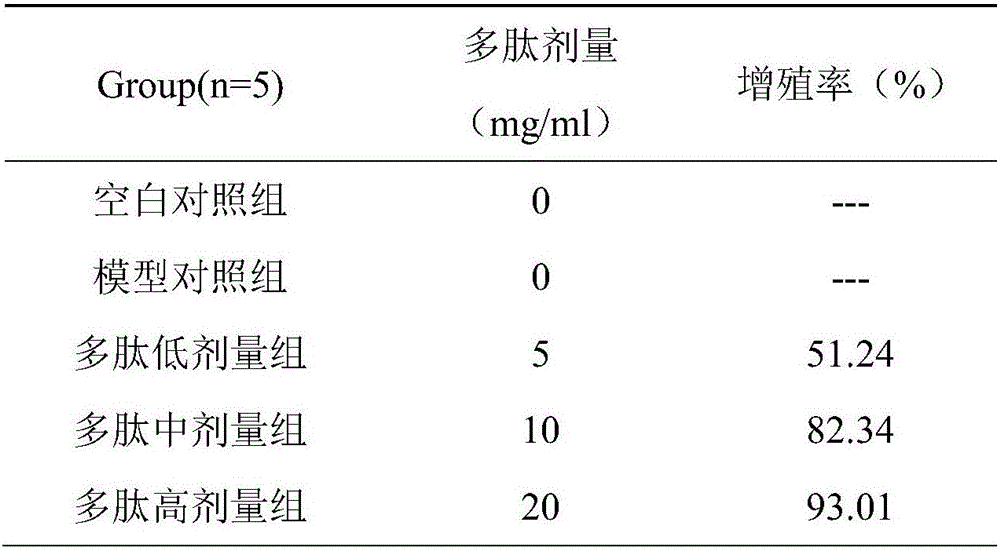Transmembrane heparan sulfate proteoglycan 1 immune agonist polypeptide and application thereof
A technology of acetylheparin sulfate and agonist, which is applied in the direction of animal/human protein, specific peptide, vertebrate antigen components, etc., can solve the problems of difficult Syndecan-1, specific T cell immunity, large molecular weight, etc., and achieve Improve the survival rate, promote the proliferation of T cells, and promote the effect of binding
- Summary
- Abstract
- Description
- Claims
- Application Information
AI Technical Summary
Problems solved by technology
Method used
Image
Examples
Embodiment 1
[0015] The in vivo activity of Syndecan-1 immune agonist polypeptide was detected by tumor model.
[0016] C57BL / 6 mice aged 6-8 weeks were randomly divided into 4 groups, half male and half male, 10 mice in each group. (1) blank group; (2) low-dose polypeptide group; (3) medium-dose polypeptide group; (4) high-dose polypeptide group. The non-small cell lung cancer tumor model was established, and immunization was carried out on the 3rd, 5th, and 7th day after inoculation of tumor cells. The scheme is: add the same volume of solvent to the blank group, and set three doses of polypeptides in the experimental group: 5, 10, and 20 mg / Kg, and inject them at multiple points around the tumor. After 21 days, the number of surviving mice was observed, and the survival rate was calculated. The results show that the polypeptide can effectively protect mice and improve the survival rate of tumor-bearing mice, and the survival rate of the dose 20mg / Kg group reaches 53.3%.
Embodiment 2
[0018] Proliferation of T lymphocytes: Spleen of mice was aseptically taken, washed 3 times with 1640 medium, ground with a 5ml syringe core, filtered with a 200-mesh screen to make a single-cell suspension, centrifuged (1000r / min, 5min), discarded Qing, Tris-NH 4 CL cracked red blood cells, put them in an ice-water bath for 3-5min, centrifuged (1000r / min, 5min), discarded the supernatant, and washed the cells twice with sterile cold PBS. Add RPMI 1640 culture fluid (5ml) of 10% calf serum to suspend the cells at last, count the cells, and adjust the cell concentration to be 5×10 6 cells / ml and cultured in 96-well culture plates.
[0019] The experiment set up a blank control group, a model group (concanavalin A, purchased from sigma company), and groups of different doses of polypeptides (5, 10, 20 mg / ml). After adding 100 μl / well of spleen lymphocyte suspension to each group, 100 μl of 1640 culture medium was added to the blank control group, ConA (final concentration was ...
Embodiment 3
[0025] The effect of Syndecan-1 immune agonist polypeptide on CD8+ T cells was determined by flow cytometry. C57BL / 6 mice aged 6-8 weeks were randomly divided into 4 groups, half male and half male, 10 mice in each group. (1) blank group; (2) low-dose immune agonist polypeptide group; (3) medium-dose immune agonist polypeptide group; (4) high-dose polypeptide group. On the 0th, 7th, and 14th day of the experiment, immunization was carried out respectively. The scheme is: add the same volume of solvent to the blank group, and set three doses of polypeptides in the experimental group: 5, 10, and 20 mg / Kg, and inject them at multiple points near the lymph nodes on the back of the mice. After 30 days, 0.8 ml of blood was taken from the eyeball, anticoagulated with heparin, and the blood cell layer was collected after centrifugation, and the red blood cells were cracked with red blood cell lysate, and the cracked red blood cells were washed away, and then fluorescently labeled mon...
PUM
 Login to View More
Login to View More Abstract
Description
Claims
Application Information
 Login to View More
Login to View More - Generate Ideas
- Intellectual Property
- Life Sciences
- Materials
- Tech Scout
- Unparalleled Data Quality
- Higher Quality Content
- 60% Fewer Hallucinations
Browse by: Latest US Patents, China's latest patents, Technical Efficacy Thesaurus, Application Domain, Technology Topic, Popular Technical Reports.
© 2025 PatSnap. All rights reserved.Legal|Privacy policy|Modern Slavery Act Transparency Statement|Sitemap|About US| Contact US: help@patsnap.com



